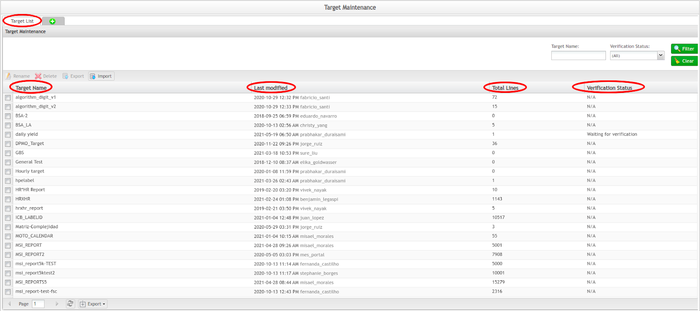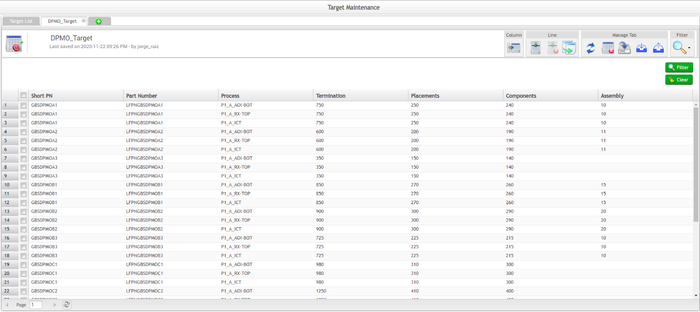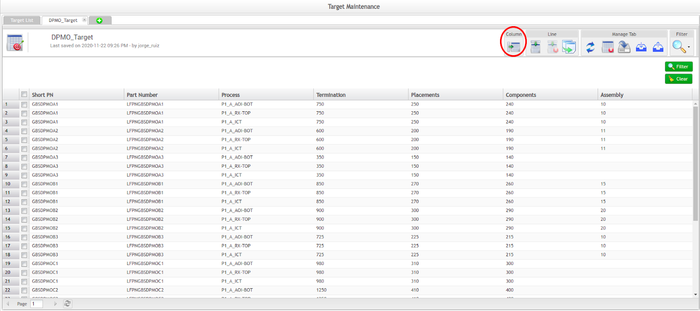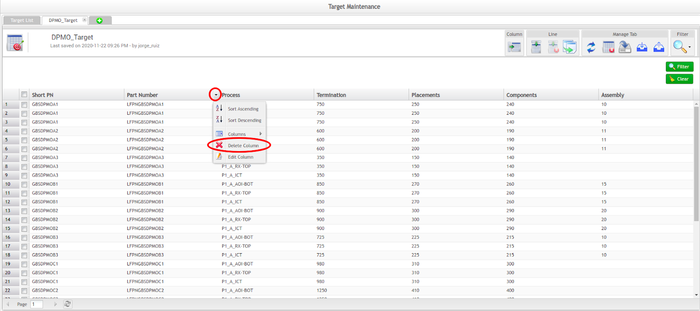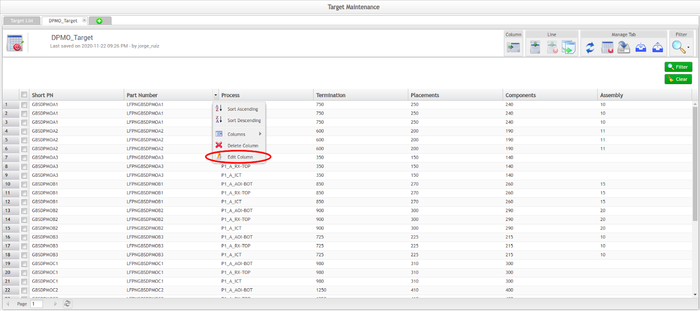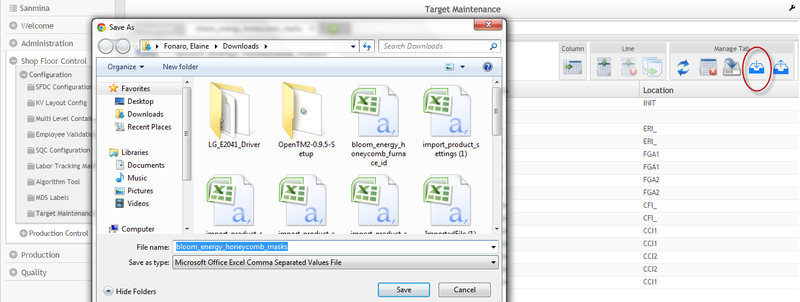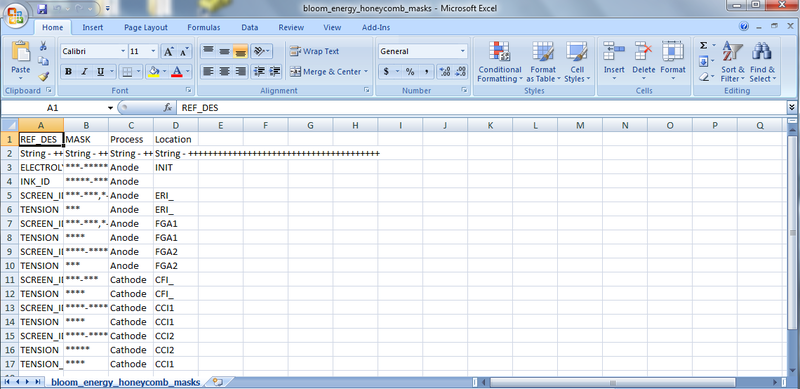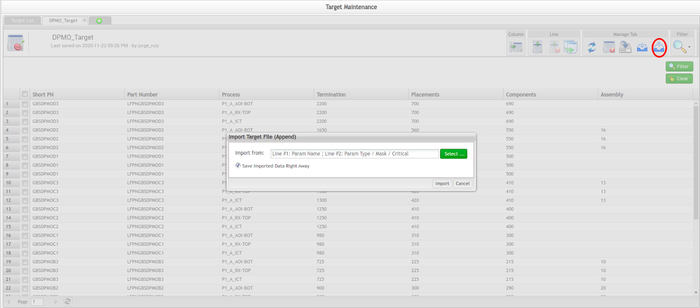SOP-MES0084 Target Maintenance
42Q Home > Shop Floor Control > Configuration > Target Maintenance
This edition applies to MES 15 Portal 1.0 and all subsequent releases and modifications until otherwise indicated in new revisions.
Target Maintenance
This SOP is intended to guide users on how to manage and maintain spreadsheets faster and more efficiently and also helps any MES Application customization. It will show users how to create data by adding columns (attributes) and defining the data type.
Targets are meant to be used as a source of any custom data.
To access the target Maintenance functionalities, the user must sign into the 42Q Portal > Shop Floor Control > Configuration expandable heading located in the menu on the left of the screen.
The Target Maintenance main page will display:
Figure 1: User Sign-in
All available Targets are listed by Target Name.
Target List
The Target List displays the following fields:
- Target Name: table name
- Last Modified: when the spreadsheet was updated and who (user) made the change
- Total Lines: the number of lines in the spreadsheet
- Verification Status: displays the target status for critical or non-critical targets
To open a Target, users have to double-click on it; Targets display in pagination mode. The quantity of items displayed per page is configurable (up to the value set in the generic attribute enable_target_pagination_view).
Users can also filter, rename and delete a Target from the Target List, moreover, it is possible to export or import a Target.
The portlet offers two methods for importing Targets, Full and Append.
Users are able to upload a single Target as well as massive Targets, around 900 to 1000 per day.
See the process of uploading massive targets below:
- On the first day, create 900 to 1000 Records per day.
- On the second day, delete the previous records (using Delete API).
- Insert the new records.
Note: When a Target has been opened and is displayed in pagination mode, before users go to the next page or filter again, the items need to be saved in order to be persisted in the database.
For more information, please refer to the Generic Attribute Maintenance SOP
Figure 2: Target List
Filter
Users can filter the available targets by Target Name.
- To filter the target list, enter the Target Name and then select Filter.
Result: The target list will display the targets according to the user’s entry.
Note: To begin a new search, select Clear to empty the fields and re-enter information into the available fields
Figure 3: Filter a Target
Add Target
Users can add a new target (empty) to add columns and lines or import a .CSV file from a local path.
1. To add a target, select the Add icon located next to the Target List tab.
Result: The target form displays.
Figure 4: Add Targets
2. Enter the Target Name; if there is a target to import, select it from the local path
3. When the user selects the checkbox Save Imported Data Right Away (selected by default), the imported target will be exactly as it is (with lines and columns filled); when left unselected, the target will be imported with only the columns and so no values are filled.
4. Select Save to complete.
Target Maintenance
Users can manage targets by double-clicking the target name in the Target List. The Target Maintenance page displays and the following functionalities will be available:
- Create Columns (Attributes)
- Create, Delete, and Copy Lines
- Manage Tab
- Reset, Delete, Save, and Download/ Upload Tab (.CSV)
Note: To save any table update, the user needs to select Save in the Manage Tab section.
Figure 5: Target Maintenance
Column (Attribute)
This functionality allows users to add columns to the selected target.
Figure 6: Target Column
Create Column
To access the Column Form in order to add a Column, the user should select Column.
Figure 7: Add Column Form
Users have to Fill in the available fields and select Insert.
- Column Name: The name of the new column.
- Mask: Enter a mask to be used in the attribute
- Type: Attribute type.
- Required: If selected, the user must add a value for the column line.
- Critical: Select this field to turn the column critical. The different statuses will be signed for the critical table. Critical columns will be displayed highlighted in yellow. If the user clicks on save, a confirmation message will be displayed and a new validation is necessary by a second user and the status for this table will be updated to “Waiting for Verification”.
The critical table has the following status:
- Input Data in Process:
- The 1st User is entering the data and he did not submit it.
- The table will be read-only for another user.
- Waiting for Verification:
- The 1st User finished to entry data and he submitted it.
- The table is waiting for another person (2nd User) to start to enter the critical data, the 2nd user will be able to view only non-critical data.
- The 1st User can no longer edit.
- Verification in Process:
- The 2nd User is entering the data and he did not submit it.
- The table will be read-only for another user.
- Passed:
- The 2nd User finished entering the data and he submitted it.
- The data from 1st User and 2nd User was matched.
- The table will be read-only for all users.
- Failed:
- The 2nd User finished entering the data and he submitted it.
- The data from 1st User and 2nd User had no mismatch.
- The data were cleared and any person can enter data again.
Note: Depending on the table status, the Column/Line and Manage Tab buttons are displayed Enable or disable.
- Add More: if selected, a new Column Form displays automatically.
- Select Save in the Manage Tab section to complete.
Delete Column
There is no rule to delete a column. To delete a column, simply roll the cursor over the column name and select Delete Column from the drop-down menu.
Figure 8: Delete Column
Select Save in the Manage Tab section to complete.
Note: If the table is at Verification In Progress, just the 2nd user entries will be deleted.
Edit Column
To edit a column, roll the cursor over the appropriate column name and select Edit Name Column from the drop-down menu.
Figure 9: Edit Column
The Edit Column Form displays. Edit the necessary fields and select Update to complete.
Figure 10: Edit Column Form
Line Menu
This section allows users to Create, Delete, and Copy lines.
Figure 11: Line Menu
Note: To save any update in the table, select Save in the Manage Tab section.
Create Line
To create lines, select the Create icon within the Line Menu and a new line will be inserted at the end of the table. Repeat this process as often as necessary.
Figure 12: Create Line
Select Save in the Manage Tab section to complete.
Delete Line
There is no rule to delete a line. Select the line to be deleted and then select the Delete icon.
Figure 13: Delete Line
Select Save in the Manage Tab section to complete. No confirmation message is displayed when the line is deleted.
Copy Line
To copy a line, select the line to be copied and select the Copy line icon.
Figure 14: Copy Line
Select Save in the Manage Tab section to complete.
Manage Tab
This section allows users to Reset, Delete, Save, Import, and Export tables.
Figure 15: Manage Tab
Reset Tab
The Reset Tab icon will clear any update performed and will restore the original table values.
Figure 16: Reset Tab
Delete Tab
There is no rule to delete a table. Select the Delete Tab icon in the Manage Tab section. A confirmation message is displayed. Select Yes to complete.
Figure 17: Delete Tab
Save Tab
The Save Tab icon will save any changes made in the target. After the target has been updated, select Save.
Figure 18: Save Tab
Export Tab
To download tables, just select the Export Tab icon and a .CSV file should be saved locally by the user.
Figure 19: Export Tab
Sample of an exported file:
Figure 20: Exported File
Import Tab
To upload a target, select the Import Tab icon and select the necessary target to be uploaded.
Figure 21: Import Tab
Filter
The users can filter the table by adding one or more filters availables.
- To filter the table, select the Filter icon, then, select the filters to be used.
Note: The selected filters will be added to the main window.
Figure 23: Enter the Information and Filter
Note: To begin a new search, select Clear to empty the fields and re-enter information into the available fields.
